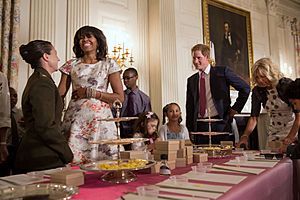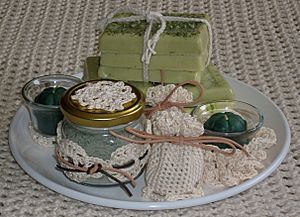Mother's Day facts for kids
Template:Infobox vevent
Mother's Day is a special day to celebrate mothers and motherhood. It also honors the strong bond between a mother and her children. This holiday is celebrated on different days around the world. Most often, it falls in March or May. It's like other family holidays such as Father's Day or Grandparents' Day.
While some countries have celebrated mothers for hundreds of years, the modern Mother's Day started in the United States. This happened in the early 1900s thanks to Anna Jarvis. She organized the first Mother's Day event at a church in Grafton, West Virginia. This church is now known as the International Mother's Day Shrine.
Over time, the American Mother's Day became very commercial. Anna Jarvis, who started it, was actually upset by all the buying and selling. She felt it took away from the true meaning. Because of this, Constance Adelaide Smith helped promote Mothering Sunday in many English-speaking countries. This holiday had a broader meaning of motherhood.
How Mother's Day Started
The modern Mother's Day began in 1907. Anna Jarvis held the first celebration at Andrews Methodist Episcopal Church in Grafton, West Virginia. This church is now a special place called the International Mother's Day Shrine.
Anna Jarvis started her campaign to make Mother's Day a holiday in 1905. This was the year her own mother, Ann Reeves Jarvis, passed away. Ann Reeves Jarvis was a peace activist. She helped wounded soldiers during the American Civil War. She also created "Mother's Day Work Clubs" to help with public health.
Another peace activist, Julia Ward Howe, had also called for a "Mother's Day For Peace" in 1870. She wanted mothers to unite and stop wars. Anna Jarvis wanted a day to honor all mothers. She believed a mother is "the person who has done more for you than anyone in the world."
In 1908, the U.S. Congress joked about making Mother's Day a holiday. They said they would also need a "Mother-in-law's Day"! But Anna Jarvis worked hard. By 1911, every U.S. state observed the holiday. West Virginia, Anna's home state, was the first to officially recognize it in 1910. Finally, in 1914, President Woodrow Wilson made Mother's Day a national holiday. It was set for the second Sunday in May.
Why Mother's Day Became Commercialized
Anna Jarvis started Mother's Day as a religious service. But she soon became unhappy with how commercial it became. It started to be called a "Hallmark holiday" because companies like Hallmark Cards began selling cards.
Jarvis felt that companies were misusing her idea for profit. She believed the holiday should be about feelings, not money. She even organized boycotts and threatened lawsuits against companies. Jarvis thought people should show love to their mothers with handwritten letters. She felt this was better than buying gifts or cards.
She protested at a candy makers' meeting in 1923. In 1925, she protested at a meeting of the American War Mothers. By then, carnations were linked to Mother's Day. The American War Mothers sold carnations to raise money. This angered Jarvis, and she was even arrested for disturbing the peace.
In Britain, Constance Adelaide Smith wanted to bring back Mothering Sunday. This was an old Christian holiday where people visited their main church. She connected it to older traditions of honoring the "Mother Church," earthly mothers, Mary, mother of Jesus, and Mother Nature. Her efforts helped make Mothering Sunday popular again in Britain and other English-speaking countries.
How Mother's Day is Spelled
In 1912, Anna Jarvis officially registered the phrase "Second Sunday in May, Mother's Day, Anna Jarvis, Founder." She made it clear that "Mother's" should be spelled with an apostrophe before the "s" (singular possessive). This means it's about each family honoring their own mother. It's not a plural possessive for all mothers in the world.
U.S. President Woodrow Wilson used this spelling in his 1914 announcement. The U.S. Congress and other presidents also used it.
When is Mother's Day Around the World?
Many countries adopted the U.S. idea of Mother's Day. But they celebrate it on different dates. Sometimes, they combine it with older celebrations of motherhood. These holidays can have different meanings, often linked to religion or history.
For example, Mothering Sunday in the United Kingdom is an older Christian holiday. In Greece, the Eastern Orthodox celebration of Jesus' presentation at the temple (February 2) is also called Mother's Day.
Some countries choose a date important to their main religion. Catholic countries might celebrate on Virgin Mary Day. Other countries pick a date with historical meaning. For instance, Bolivia's Mother's Day remembers a battle where women fought to protect their children.
Some countries, like Russia, celebrate International Women's Day instead of Mother's Day. Others, like Ukraine, celebrate both.
Here are some examples of when Mother's Day is celebrated:
- Second Sunday of February: Norway
- 3 March: Georgia
- 8 March: Many countries, often with International Women's Day, like Albania, Armenia, Azerbaijan, Belarus, Bosnia and Herzegovina, Bulgaria, Kazakhstan, Moldova, Russia, and Vietnam.
- Fourth Sunday in Lent: (Mothering Sunday) Ireland, Nigeria, United Kingdom.
- 21 March: Many Arab countries like Egypt, Iraq, Jordan, Kuwait, Lebanon, Saudi Arabia, and Syria.
- First Sunday of May: Hungary, Lithuania, Portugal, Romania, Spain.
- Second Sunday of May: This is the most common date, including Australia, Canada, China, Germany, India, Japan, New Zealand, Philippines, South Africa, Turkey, Ukraine, and United States.
- 10 May: El Salvador, Guatemala, Mexico.
- Last Sunday of May: Algeria, Dominican Republic, France (unless it's Pentecost, then first Sunday of June), Sweden.
- 12 August: Thailand (Queen Sirikit's birthday).
- 14 October: Belarus.
- Third Sunday of October: Argentina.
- 16 November: North Korea.
- 8 December: Panama (Feast of the Immaculate Conception).
- 22 December: Indonesia.
Mother's Day Traditions in Different Countries
Mother's Day traditions vary greatly around the world. In some places, it's very important to celebrate your mother. In others, it's a newer holiday, often influenced by the U.S. celebration.
Mother's Day and Religion
In some Christian traditions, Mother's Day is linked to honoring the Virgin Mary. Some Catholic, Lutheran, and Anglican families have special altars for Mary. Many Eastern Catholic and Eastern Orthodox Churches hold special prayer services for the Theotokos (Virgin Mary).
In Islam, there isn't a specific Mother's Day. However, the Quran teaches children to love their mother even more than their father.
In Hindu tradition, there's a holiday called "Mata Tirtha Aunshi" or "Mother Pilgrimage fortnight." It's celebrated in countries with Hindu populations, especially Nepal. Mothers are honored with special foods. This holiday is much older than the U.S.-inspired Mother's Day.
In Buddhism, the Ullambana festival comes from the story of Maudgalyayana and his mother.
Mother's Day in Australia
In Australia, Mother's Day is on the second Sunday in May. It was first celebrated in 1910. But it became popular in the 1920s. The tradition of giving gifts started in 1924. A woman named Janet Heyden collected gifts for lonely mothers in a hospital. These mothers had lost family members in World War I. Since Mother's Day is in autumn in Australia, white chrysanthemums are the traditional flower. Carnations are spring flowers, so they are not as common there.
Mother's Day in China
Mother's Day is becoming more popular in China. Carnations are a very common gift. In 1997, Mother's Day was set as a day to help poor mothers in rural areas. The Chinese government's newspaper, the People's Daily, said that Chinese people accept the holiday easily. This is because it fits with their traditional values of respecting elders and parents.
Recently, a Communist Party member named Li Hanqiu has pushed for an official Mother's Day. He wants to honor Meng Mu, the mother of the famous philosopher Mèng Zǐ. He suggests giving lilies instead of carnations. In ancient China, mothers planted lilies when their children left home. Mother's Day is still not an official holiday in most of China.
Mother's Day in Mexico
In Mexico, Mother's Day, or "Día de las Madres," is celebrated on May 10th. This date was chosen in the early 1940s by President Anastasio Somoza García. It was his wife's mother's birthday.
It's a tradition to start the celebration with the famous song "Las Mañanitas." Families usually gather to spend time with their mothers. They might share a meal at home or go to a restaurant.
Mother's Day in the United States

The United States celebrates Mother's Day on the second Sunday in May. In 1872, Julia Ward Howe suggested a "Mother's Day for Peace." She wanted women to unite for disarmament. Her idea was about mothers organizing against war, not just honoring them.
Mother's Day is one of the biggest days for selling flowers and greeting cards in the U.S. It's also the busiest day for long-distance phone calls. Many people go to church on Mother's Day. It has the highest church attendance after Christmas Eve and Easter. Worshippers often wear carnations. Colored ones mean their mother is living, and white ones mean she has passed away.
Mother's Day continues to be very successful for businesses in the U.S. Some believe the holiday might not have lasted without the support of flower and other commercial industries. Other holidays from the same time, like Children's Day, are not as popular today.
Images for kids
See also
 In Spanish: Día de la Madre para niños
In Spanish: Día de la Madre para niños







